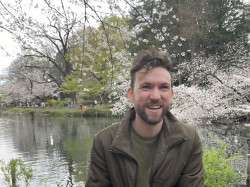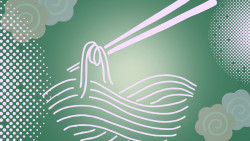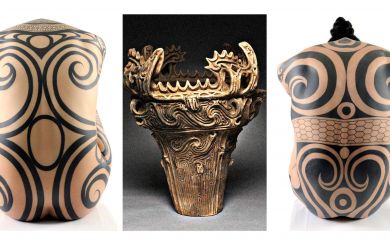
Originally published on metropolis.co.jp on February 2012

Two hours and twenty minutes of pummelling, shriek-filled, melodic metal, topped off with a version of “Living After Midnight” that bears a close enough resemblance to the version every metal fan carries round in his head, and you start wondering what drives men like Halford, Hill, and Tipton, at their ages (60, 61, 64), to do a show of such Godzillean proportions and power. I mean, this show in Tokyo is louder, longer and way better than it strictly needs to be with an audience that seems inclined to accept whatever it’s given. Also, it’s the “Epitaph Tour,” so even if the punters feel short-changed they can’t very well punish the band by not coming next time.
A cynic might say the clue is in the show’s format: Priest album covers from the last 40 years projected onto a screen behind the band as they crank out excellent versions of 21 of their most affectionately remembered songs. Hard sell? Maybe. If so, the tour could be renamed “The Retirement Fund Tour,” as the boost to album sales around the world should put quite a few pennies in the pension coffers. And, at least tonight, the fact that we’re catching the band in one of its classic settings—the legendary Budokan, where their 2005 DVD “Rising In The East” was shot—is sure to endear them to the record-buying public even more.
But, hang on! That can’t be right. Everybody here already seems to know most of the words to most of the choruses, so they must already have well-stacked Priest collections back home; so hard sell, maybe not. The only other explanation is one of deep mutual love between band and audience, a much more likely explanation. I’m actually surprised that no one’s in tears at the fact that this is supposed to be the last gig ever by Priest in Japan. Before this one they had done five others in Japan, including a last minute addition to the tour.
They kick off the night with the fast flowing pace of “Rapid Fire” followed by the more deliberate pile-driving rhythms of “Metal Gods,” sending out the signal that things are going to be either fast or heavy and probably both, as Rob stalks the stage, bearded, bald, and resplendent in leather, and Tipton cuts a faintly comic figure in his trademark leather red pantaloons that almost evoke an eccentric character from Japanese manga.
After the first opening burst, Rob touches base with audience with a few words of greeting while the multi-headed beast hollers back its appreciation. After a slightly stoner rock influenced version of “Heading Out to the Highway,” “Judas Rising,” with its mixture of menace and exaltation plays to Halford’s strengths, while the duelling guitars of Tipton and new recruit Richie Faulkner create a potent backdrop.
Distorted guitar scales and a laser show announce “Victim of Changes,” a sprawling epic that was originally stitched together, like Frankenstein’s monster, from the body parts of other songs. It is to Priest what “Bohemian Rhapsody” was to Queen, and represents the band’s first real challenge of the night. Scott Travis nails the thundering rhythms and Halford manfully keeps on top of it all with another powerful performance, but the song loses some of its momentum in the middle when Tipton does a bit too much guitar noodling, but this seems to prepare him for a gutsy, scintillating solo later in the song.
The next big challenge is “Diamonds and Rust.” This is essentially a gentle hippy song by 60s folkster Joan Baez that has fluttered out of the sunlight, like a little lost bird, into the dark, fiery hell-like abode of heavy metal, and in the process been transformed into a screaming eagle. It is this contrast in styles expertly handled by Priest that have made this song such a classic for the band, but its delicate alchemy means that it is also a hard act to get right every time.
Soft keyboard lines and acoustic strumming create a mood of gentle reverie that is then brutally and beautifully demolished by the cranked-up metal attack with which the band finishes the song. Effective though this is, somehow tonight it seems to miss the mark.
The band is on safer terrain with the monster riff of “Prophecy,” from last album “Nostradamus,” as Halford tours the stage in a golden hooded cloak like an extra out of “Eyes Wide Shut,” and the pummelling paean to demonic attack that is “Night Crawler.” At times he seems like a bulldog, his jaws firmly clamped onto the song with no hint of compromise, his body hunched over as if to squeeze every ounce of power from his formidable larynx.
The words that he spoke to me in 2002 when I asked him how it felt to perform metal on stage now come to mind:
“It’s a physically demanding performance. It’s not like standing there plink plonking some Country and Western song. I mean you’re out there flailing and waving with the volume and the sweat, the lights and the power, and the noise and the racket. It’s just complete bedlam. Absolute chaos. It’s amazing you know.”
Ten years on and he’s still as physically committed as ever.
The alternation of hard ‘n’ heavy with soft ‘n’ melodic elements in “Beyond the Realms of Death” and “Blood Red Sky” keeps the energy levels high while also giving the audience room to breathe and a moment to realize where they are. Looking around the Budokan, it is certainly an impressive sight, with its layered octagonal ceiling, from which a giant Japanese flag is suspended.
After more than 100 minutes of metal, and energetic crowd-pleasing versions of “The Green Manalishi” and “Breaking the Law,” the band shows its first sign of weakness, going off stage while Travis does an extended drum intro for “Painkiller.” Last year Whitesnake used the same trick, but while theirs lasted over ten minutes and got tedious, the other four members of Priest are only gone for a couple of minutes—enough time for a slash and possibly an energy drink (like true gods and unlike many bands today, they don’t like mere mortals to see them taking any kind of sustenance onstage).
The break is short enough so that little momentum is lost, and we launch into a relentless and blistering version of “Painkiller” which should be re-titled “Paintkiller” as Halford proceeds to peel the gloss from the venue’s eight walls with screeching high notes that would put a Stuka dive bomber to shame.
“The Hellion” and “Hell Bent for Leather” keep up the momentum and the realization starts to dawn that the longer they play the stronger they get. The interplay between Tipton and Faulkner is fluid and inspired, and Halford is still a man on a mission. When they use gimmicks, they don’t even need them. The Harley Davidson motorbike that Halford rides on stage at the start of “Hell Bent for Leather” is nice in the way that a quaint ritual is nice, but hardly necessary for a song that evokes so perfectly the smell of burnt rubber and scuffed leather.
After a spot of call-and-response yodelling to loosen up the audience’s vocal chords, Priest launch into the big, fat, juicy riff of “You’ve Got Another Thing Comin.” A temporary spot of raggedness in Halford’s voice is skilfully covered up by Tipton’s squealing guitar as he continues his duel with Faulkner, but Halford digs deep and the voice is back as strong as ever.
Plectrums and drumsticks are thrown into the audience and Tipton clambers down to the front row to press the flesh before exiting, but they’re soon back for an encore with crowd favourite “Livin’ After Midnight.” After two hours and twenty minutes the performance is so fresh it could be their first song. Then in the dying feedback embers of that song, Halford enigmatically says, “The Priest will be back.” Force of habit or gnostic premonition? If the latter, the quality of tonight’s show makes perfect sense.







